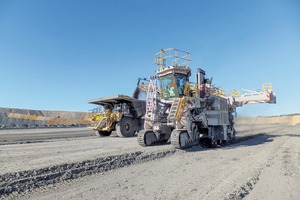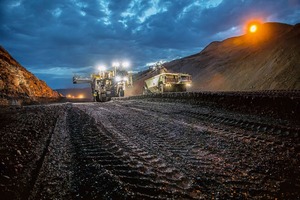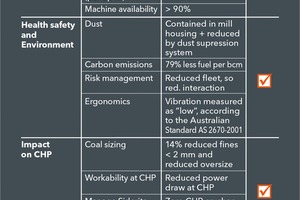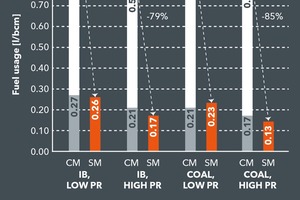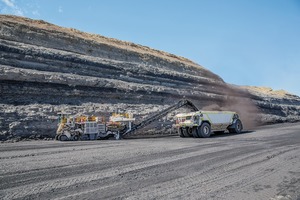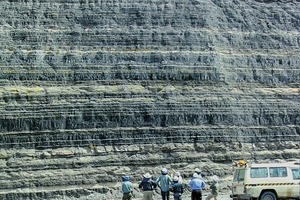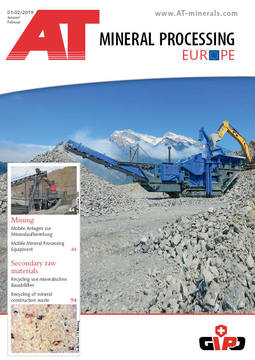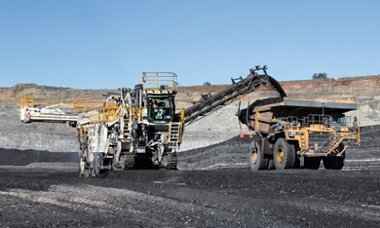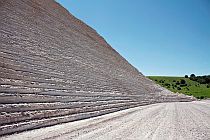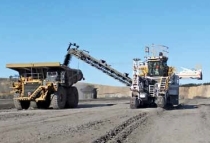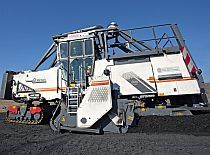Surface miners drive up savings in coal mining
The main advantages of Wirtgen surface mining technology include the following:
Selective mining
Avoidance of blasting
Cutting, crushing and loading in a single operation
Maximum exploitation of deposits
Reduced transport costs
Wirtgen supplies surface miners in a variety of performance classes for the selective mining of commodities, such as coal, limestone, bauxite, gypsum, salt and phosphate (Fig. 2). In addition to mining, these machines can also carry out routing operations for constructing roads and railway tracks, rehabilitating roadways and installing tunnel floors. The range of applications further includes the precision cutting of ditches and channels as well as surface leveling. In collaboration with RWTH Aachen University, Wirtgen conducted a study in a black coal mine in Queensland/Australia. This article will explore the advantages that surface miners offer in coal mining based on the results of this study.
Case study
The 4200 SM surface miner was integrated into an ongoing operation for the selective mining of coal and interburden. Previously defined targets were checked regularly to determine if they were being met. The project score card (Fig. 3) illustrates the advantages of using a surface miner in this mine.
The production rates of the surface miner were compared with that of the previously used rip-and-stack method over a period of four months based on various performance indicators. The conventional mining system comprises two supersize dozers for ripping and stacking the material and a super-large wheel loader for loading it to dump trucks with payloads of 130 – 190 t.
Better HSE
Compared to the three mining machines used at the mine previously, using a surface miner significantly reduced noise emissions. Mining with the 4200 SM likewise has a positive impact on dust emissions. In contrast to the dozers and wheel loader - all of which generate considerable quantities of dust that impact the work environment - the dust produced by a surface miner is contained in the cutting drum housing. A dust suppression system comprising an integrated water spray system also helps to additionally reduce and bind the dust.
An analysis of the two mining methods further demonstrated that fuel consumption is about 79 % lower – and therefore also CO2 emissions – with surface miners than when using the conventional method (Fig. 4). The lower number of machines in use additionally has a positive effect on risk management, because fewer machines mean a reduced risk of accident at the mine.
The surface miner‘s anti-vibration cabin offers better ergonomics and optimized working conditions for the machine operator. The vibrations generated in the 4200 SM were rated as “low” according to Australia‘s AS 2670-2001 standard, while the ratings for the conventional systems were higher.
Lower processing costs thanks to reduced fines
Coal seams generally are of varying thickness and separated by interburden layers. Precisely separating the various materials is of tremendous importance if coal is to be mined as cost-efficiently as possible, because it significantly reduces processing costs. Another major cost driver in this regard is the percentage of fines, because they are much more costly to process than coarse material.
For the study, a total of 100 samples (30 t each) were analyzed during operation of the surface miner to determine the particle size distribution. Those samples were compared with similar ones taken from the conventional mining equipment and identical mining fields. Significant advantages emerged when working with the surface miner, which produced 14 % fewer fines at grain sizes of less than 2 mm compared to the conventional mining system. The portion of fines to be processed dropped by 22 % at grain sizes of less than 1 mm and even by 36 % at grain sizes of less than 0.5 mm. Further savings were achieved by significantly reducing the quantity of oversize. For example, only 17 % of the material mined by the surface miners had to be crushed compared to 26 % for the dozers.
The deposit analyzed in the study contains siderite intrusions, particularly at the boundary between seam and interburden. In the conventional process, this frequently led to difficulties, because the siderite intrusions are very hard and therefore difficult to mine. As a result, dozers frequently produce oversized siderite boulders that cause blockages in the crusher. This is not the case when mining with a surface miner. In addition, working with a surface miner reduced coal mining losses and dilution of coal in the mine. This leads to more product, hence increased turnover and even an improved exploitation of the deposit and thus a better stripping ratio.
Three tasks in a single operation
Wirtgen surface miners can cut, crush and directly load material onto trucks or dumpers in a single operation (Fig. 5). This saves time and the additional cost of purchasing machinery and fuel. Working with the 4200 SM in the Australian mine resulted in a 79 % reduction in fuel consumption per cubic meter of mined material. Labor costs were reduced by 60 % and mining unit costs per ton were reduced by 60 % compared to the conventional mining method.
The score card clearly demonstrated that - when the entire process chain is taken into consideration - mine operators benefit from tremendous cost reductions when using a surface miner. These reductions are not only a result of easier processing. The smaller number of mining machines and reduced manpower described above and the avoidance of additional costs for transporting and processing waste rock also contribute significantly to the good overall score achieved by the surface miner.
Not all benefits that result from the surface miner were part of the conducted study. Additional benefits are described below.
Avoiding blasting means avoiding danger
With surface miners, drilling and blasting can be eliminated. In other words, even commodities located in the vicinity of residential areas, public roads or other infrastructure can be effectively mined. It is likewise possible to mine resources located in buffer and safety zones.
In most cases, planning and execution of blasting work is associated with considerable effort, high costs and regulatory restrictions. In fact, eliminating drilling and blasting relieves the people responsible of a number of challenges. Mine operators no longer need to spend time obtaining the required permits, hiring certified blast personnel or compiling the associated documentation. Furthermore, getting rid of drilling and blasting has a very positive impact on public opinion, meaning that opencast mining operations can proceed without causing friction in a community.
The following are further advantages of eliminating drilling and blasting:
Enhanced safety at the mine because no explosives need to be stored
No boulder handling necessary
Less impact on the environment (vibration, dust and noise)
No interruptions for blasting (production delays)
Improved slope stability
Reduced rockfall
Better re-cultivation of embankments
The use of a surface miner also has a positive effect on water management at an opencast mine. The cut surfaces are levelled and can be cut at an angle. Drainage is further improved as a result and water seepage into the ground is reduced.
Haulage: more tons per hour
The major cost factor in opencast mining is haulage. Mining with Wirtgen surface miners produces level surfaces that serve as stable roadways, supporting the rapid transport of material. This increases the transport capacity of the entire truck fleet. Even wear on tires, frame and suspension is reduced thanks to the quality of the roadways, making it possible also to employ standard on-highway trucks.
Surface miners improve quality and cost-efficiency
In recent years, Wirtgen has conducted several large-scale field tests on particle size distribution and ROM material degradation. In these studies, coal and sedimentary ore from eight different pits were analyzed to determine their particle size distribution. Some 8000 t of material were screened to compare the material produced by surface miners with that extracted by conventional mining methods (Fig. 6).
All of the studies illustrate that using Wirtgen surface miners delivers compelling improvements in final product quality, cost-efficiency, environmental protection and safety. In order to fully exploit the surface miners‘ profit potential an analysis should be conducted when starting the planning of a mining project.
//www.wirtgen.com" target="_blank" >www.wirtgen.com:www.wirtgen.com

